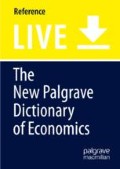Abstract
Precautionary saving measures the consequences of uncertainty for the rate of change (and therefore the level) of wealth. The qualitative aspects of precautionary saving theory are now well established: an increase in uncertainty will increase the level of saving, but will reduce the marginal propensity to save. Quantitatively, theory combined with empirical estimates of risk aversion suggests that precautionary saving and precautionary wealth should be quite large. More direct empirical evidence on precautionary saving suggests that precautionary effects on saving are substantial, but the magnitude of the effects is disputed, and the different estimates are not all expressed in comparable units.
This chapter was originally published in The New Palgrave Dictionary of Economics, 2nd edition, 2008. Edited by Steven N. Durlauf and Lawrence E. Blume
Bibliography
Barsky, R.B., N. Gregory Mankiw, and S.P. Zeldes. 1986. Ricardian consumers with Keynesian propensities. American Economic Review 76: 676–691.
Browning, M.J., and A. Lusardi. 1996. Household saving: Micro theories and micro facts. Journal of Economic Literature 34: 1797–1855.
Cagetti, M. 2003. Wealth accumulation over the life cycle and precautionary savings. Journal of Business and Economic Statistics 21: 339–353.
Carroll, C.D. 2000. Solving consumption models with multiplicative habits. Economics Letters 68: 67–77.
Carroll, C.D. 2001. Death to the log-linearized consumption Euler equation! (and very poor health to the second-order approximation). Advances in Macroeconomics 1, Article 6.
Carroll, C.D. 2004. Theoretical foundations of buffer stock saving. Working paper no. 10867. Cambridge, MA: NBER.
Carroll, C.D. and M. S. Kimball. 2005. Liquidity constraints and precautionary saving. Manuscript, Johns Hopkins University. Online. Availeable at: http://econ.jhu.edu/ccarroll/liquidRevised.pdf. Accessed 31 May 2007.
Carroll, C.D., and A.A. Samwick. 1997. The nature of precautionary wealth. Journal of Monetary Economics 40: 41–71.
Carroll, C.D., and A.A. Samwick. 1998. How important is precautionary saving? The Review of Economics and Statistics 80: 410–419.
Drèze, J.H., and F. Modigliani. 1972. Consumption decisions under uncertainty. Journal of Economic Theory 5: 308–335.
Dynan, K.E. 1993. How prudent are consumers? Journal of Political Economy 101: 1104–1113.
Engen, E., and J. Gruber. 2001. Unemployment insurance and precautionary saving. Journal of Monetary Economics 47: 545–579.
Fuchs-Schündeln, N., and M. Schündeln. 2005. Precautionary savings and selfselection: Evidence from the German reunification ‘experiment’. Quarterly Journal of Economics 120: 1085–1220.
Gourinchas, P.-O., and J. Parker. 2002. Consumption over the life cycle. Econometrica 70: 47–89.
Guiso, L., T. Jappelli, and D. Terlizzese. 1992. Earnings uncertainty and precautionary saving. Journal of Monetary Economics 302: 307–337.
Huggett, M. 2004. Precautionary wealth accumulation. Review of Economic Studies 71: 769–781.
Hurst, E., A. Lusardi, A. Kennickell and F. Torralba. 2005. Precautionary savings and the importance of business owners. NBER working paper no. 11731.
Kazarosian, M. 1997. Precautionary savings – a panel study. The Review of Economics and Statistics 79: 241–247.
Kennickell, A. and A. Lusardi 2005. Disentangling the importance of the precautionary saving motive. Working paper, Dartmouth College.
Kimball, M.S. 1990. Precautionary saving in the small and in the large. Econometrica 58: 53–73.
Kimball, M.S., C.R. Sahm, and M.D. Shapiro. 2005. Imputing risk tolerance from survey responses. Michigan: University of Michigan.
Kimball, M.S., and P. Weil. 2004. Precautionary saving and consumption smoothing across time and possibilities. Michigan: University of Michigan.
Kreps, D.M., and E.L. Porteus. 1978. Temporal resolution of uncertainty and dynamic choice theory. Econometrica 46: 185–200.
Laibson, D. 1997. Golden eggs and hyperbolic discounting. Quarterly Journal of Economics 112: 443–477.
Leland, H.E. 1968. Saving and uncertainty: The precautionary demand for saving. Quarterly Journal of Economics 82: 465–473.
Low, H., C. Meghir, and L. Pistaferri. 2005. Wage risk and employment over the life cycle. Stanford: Stanford University.
Lusardi, A. 1997. Precautionary saving and subjective earnings variance. Economics Letters 57: 319–326.
Lusardi, A. 1998. On the importance of the precautionary saving motive. American Economic Review 88: 449–453.
Miller, B.L. 1976. The effect on optimal consumption of increased uncertainty in labor income in the multiperiod case. Journal of Economic Theory 13: 154–167.
Palumbo, M.G. 1999. Uncertain medical expenses and precautionary saving near the end of the life cycle. Review of Economic Studies 66: 395–421.
Sibley, D.S. 1975. Permanent and transitory effects of optimal consumption with wage income uncertainty. Journal of Economic Theory 11: 68–82.
Toché, P. 2005. A tractable model of precautionary saving in continuous time. Economics Letters 87: 267–272.
Zeldes, S.P. 1989. Optimal consumption with stochastic income: Deviations from certainty equivalence. Quarterly Journal of Economics 104: 275–298.
Author information
Authors and Affiliations
Editor information
Editors and Affiliations
Copyright information
© 2008 The Author(s)
About this entry
Cite this entry
Carroll, C.D., Kimball, M.S. (2008). Precautionary Saving and Precautionary Wealth. In: The New Palgrave Dictionary of Economics. Palgrave Macmillan, London. https://doi.org/10.1057/978-1-349-95121-5_2079-1
Download citation
DOI: https://doi.org/10.1057/978-1-349-95121-5_2079-1
Received:
Accepted:
Published:
Publisher Name: Palgrave Macmillan, London
Online ISBN: 978-1-349-95121-5
eBook Packages: Springer Reference Economics and FinanceReference Module Humanities and Social SciencesReference Module Business, Economics and Social Sciences

